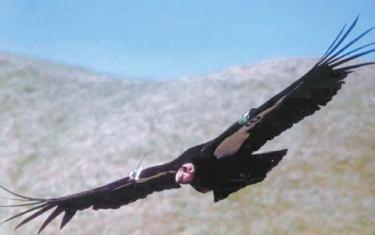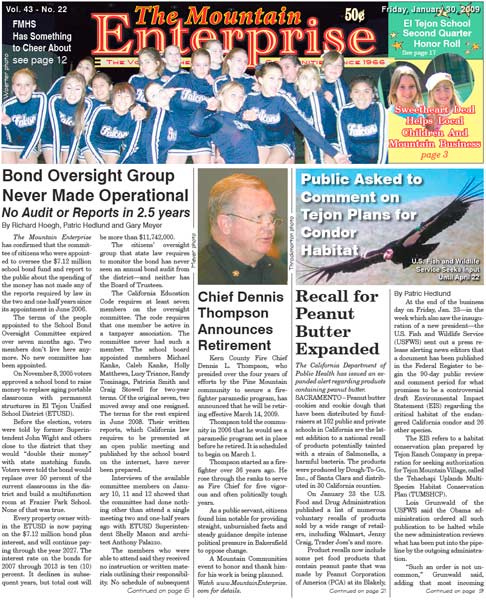
U.S. Fish and Wildlife Service seeks input until April 22. The draft EIS may be viewed at www.fws.gov/ventura.
By Patric Hedlund
At the end of the business day on Friday, Jan. 23—in the week which also saw the inauguration of a new president—the U.S. Fish and Wildlife Service (USFWS) sent out a press release alerting news editors that a document has been published in the Federal Register to begin the 90-day public review and comment period for what promises to be a controversial draft Environmental Impact Statement (EIS) regarding the critical habitat of the endangered California condor and 26 other species.
The EIS refers to a habitat conservation plan prepared by Tejon Ranch Company in preparation for seeking authorization for Tejon Mountain Village, called the Tehachapi Uplands Multi-Species Habitat Conservation Plan (TUMSHCP).
Lois Grunwald of the USFWS said the Obama administration ordered all such publication to be halted while the new administration reviews what has been put into the pipeline by the outgoing administration.
“Such an order is not uncommon,” Grunwald said, adding that most incoming administrations issue orders to freeze Federal Register publication of such items during a transition review period.
“But somehow the EIS slipped through the cracks and got published last week,” Grunwald said.
Tejon Ranch Company’s conservation plan for habitat of the California condor (and a score of other threatened and endangered plant and animal species) did not get published in the Federal Register along with the USFWS impact statement, she said. The USFWS has placed both documents on their website however.
The footprint of Tejon Ranch Company’s proposed Tejon Mountain Village puts about 3,500 homes, resort hotels and commercial areas adjacent to critical habitat for the condor.
Tejon spokesman Barry Zoeller wrote in an email January 26, “Of all the condor critical habitat on Tejon Ranch within the boundaries of the TUMSHCP (high quality condor foraging habitat), approximately 94 percent will be protected as permanent open space.” Tejon Mountain Village will encroach on four percent of the habitat, he said. Two percent is the existing National Cement plant lease.
The Fish and Wildlife Service’s draft Environmental Impact Statement explains the agency’s evaluation of Tejon’s plan to protect the habitat while proceeding with its development and ranching activities.
The public is asked to review and comment on the draft Environmental Impact Statement until April 22.
After that time USFWS will make a decision about granting the permit requests, Grunwald said.
Public input on Tejon Ranch Company’s habitat conservation plan can also be submitted within that period, but an additional public review and input period will be announced once the HCP is officially published in the Federal Register, Grunwald said.
The statements and plan are required as part of Tejon’s request for an “incidental take permit” to disturb or cause the death of some threatened or endangered species. It is not requesting such a permit for the California condor.
On June 4, 2008, Tejon Ranch Company issued a statement saying “the proposed Tehachapi Uplands Multi- Species Habitat Conservation Plan, which would require the approval of the U.S. Fish and Wildlife Service, provides comprehensive protection for [now 27] different species of plants and animals that inhabit the Tehachapi Mountains….”
The press release emphasized that Tejon Ranch is not seeking a lethal take permit for the California condor.
“The characterization by some of the TUMSHCP as ‘a license to kill condors’ is therefore inflammatory and false,” the Tejon statement declared, adding that hunting is not classified as a “covered activity” under the MSHCP.
These are sensitive issues to Tejon Ranch Company and to residents of the Mountain Communities for several reasons.
First, during the ongoing efforts to rescue the condor from extinction, Tejon Ranch sued the government to try to prevent naturalists from returning the endangered species to the essential high ridges of condor habitat that are located on Tejon Ranch property. Second, according to interviews with the USFWS, the development company did in fact explore the possibility of securing a “lethal take” permit for the condor, but backed away from that tactic in 2008. Third, the most experienced remaining condor born and matured in the wild—a 50-year-old matriarch known as AC-8 that was critical to the condor preservation program—was shot and killed by a hunter during a commercial wild pig hunt conducted by Tejon Ranch in February 2003.
In the past two year Tejon Ranch Corporation management appears to have altered course. In 2008 the company banned use of lead bullets on its property. A ban on use of lead bullets in condor habitat also became California state law in the 2008 hunting season. Lead poisoning from bullet fragments in carrion remians eaten by condor has been discovered as a major cause of wild condor deaths. Lead poisoning also leads to neurologic damage, affecting navigation. This is suspected to be a cause of some condor collisions with power lines.
In 2008 the company also announced a major phased agreement with five environmental organizations including the Sierra Club and the Audobon Society to preserve a significant portion of the Tejon Ranch holdings, although the full implementation is dependent upon the company successfully acquiring permission to build according to its plans.
A part of the contract signed by the groups was an agreement not to object to the company’s revised plans for development of its Tejon Mountain Village, Centennial and Tejon Industrial Complex.
In addition to eliminating use of ammunition containing lead in the ranch’s hunting program, the conservation plan includes burying new utility lines underground; adjusting development away from potential condor foraging areas; providing supplemental condor feeding stations; providing GPS tracking devices that can help identify when birds are in trouble and where to find them; employing a full-time, on-site biologist to monitor the conservation effort’s effectiveness; developing a condor education program for residents and guests; and establishing a 37,000-acre Fish and Wildlife Service condor study area.
The USFWS environmental impact statement lists additional species including the American peregrine falcon, the golden eagle, the burrowing owl, the western spadefoot toad, Tehachapi slender salamander, the yellow-blotched salamander and western yellow-billed cuckoo that are to be protected under the plan.
If the Tejon Ranch plan is accepted, a 50-year incidental take permit will be granted to the company to indemnify it from legal liability for causing disturbance that may lead to the death of a protected animal as the company conducts its ranching and construction activities.
“Under no circumstances does the plan permit the lethal take of condors,” Zoeller said.
Biologists who are still reviewing the plan are concerned that condors are attracted to human activity. They pick up bits of microtrash that humans seem to shed unconsciously—bottle caps, bolts, bits of wire, pop tops—that resemble the shards of calcium-rich bone that condor feed to their chicks. Microtrash has been found in the stomachs of several dead chicks, leading biologists to wonder if it is possible for wild condor to ever survive adjacent to humans.
Lois Grunwald said repeatedly that the USFWS draft “does not make conclusions.”
“The Fish and Wildlife Service will be evaluating the impact to critical habitat after the USFWS has reviewed public comments (after the public comment period has closed April 22) and prior to the FWS decision on whether to issue an incidental take permit to Tejon Ranch Company.”
She said the USFWS service has issued thousands of incidental take permits to companies across the country, and that commercial activity within critical habitat has often been allowed.
The pubic comment period extends for 90 days, to April 22.
This is part of the January 30, 2009 online edition of The Mountain Enterprise.
Have an opinion on this matter? We'd like to hear from you.


